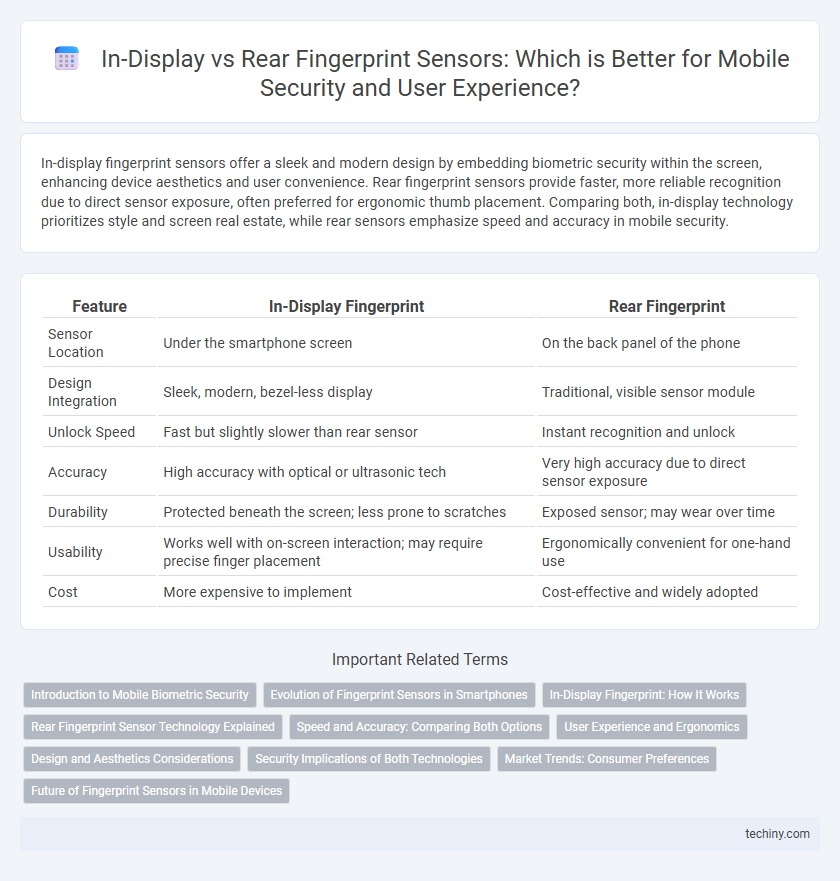In-display fingerprint sensors offer a sleek and modern design by embedding biometric security within the screen, enhancing device aesthetics and user convenience. Rear fingerprint sensors provide faster, more reliable recognition due to direct sensor exposure, often preferred for ergonomic thumb placement. Comparing both, in-display technology prioritizes style and screen real estate, while rear sensors emphasize speed and accuracy in mobile security.
Table of Comparison
| Feature | In-Display Fingerprint | Rear Fingerprint |
|---|---|---|
| Sensor Location | Under the smartphone screen | On the back panel of the phone |
| Design Integration | Sleek, modern, bezel-less display | Traditional, visible sensor module |
| Unlock Speed | Fast but slightly slower than rear sensor | Instant recognition and unlock |
| Accuracy | High accuracy with optical or ultrasonic tech | Very high accuracy due to direct sensor exposure |
| Durability | Protected beneath the screen; less prone to scratches | Exposed sensor; may wear over time |
| Usability | Works well with on-screen interaction; may require precise finger placement | Ergonomically convenient for one-hand use |
| Cost | More expensive to implement | Cost-effective and widely adopted |
Introduction to Mobile Biometric Security
In-display fingerprint sensors offer a seamless and modern integration of biometric security by embedding the scanner beneath the smartphone screen, enhancing aesthetics and usability. Rear fingerprint sensors, typically positioned on the back of the device, provide quick access but can be less ergonomic when the phone is placed on flat surfaces. Mobile biometric security leverages these fingerprint technologies to ensure fast, reliable, and secure user authentication, protecting sensitive data and enabling secure mobile transactions.
Evolution of Fingerprint Sensors in Smartphones
Fingerprint sensors in smartphones have evolved from rear-mounted capacitive sensors to advanced in-display optical and ultrasonic technologies, offering enhanced security and seamless user experience. In-display fingerprint sensors allow users to unlock devices without physical buttons, integrating authentication directly under OLED or AMOLED screens. This evolution reflects the shift towards more ergonomic designs and improved sensor accuracy driven by advancements in biometric technology.
In-Display Fingerprint: How It Works
In-display fingerprint sensors utilize optical or ultrasonic technology to capture a detailed image of the fingerprint through the smartphone's screen, allowing secure biometric authentication without a physical sensor. Optical sensors use light to illuminate and photograph the fingerprint pattern, while ultrasonic sensors emit high-frequency sound waves to map the fingerprint's ridges and valleys in three dimensions. This technology integrates seamlessly with AMOLED and OLED displays, enhancing device aesthetics and enabling larger screen-to-body ratios compared to traditional rear fingerprint scanners.
Rear Fingerprint Sensor Technology Explained
Rear fingerprint sensor technology utilizes capacitive or optical sensors embedded on the back of smartphones, offering ergonomic ease by allowing natural thumb placement during device unlocking. Capacitive sensors detect electrical impulses from the skin's ridges, providing high accuracy and speed, while optical variants capture a detailed image of the fingerprint using light, supporting reliable authentication even with slight moisture or dirt. Positioned away from the screen, rear sensors help maintain bezel-less displays and reduce repair costs compared to in-display fingerprint modules.
Speed and Accuracy: Comparing Both Options
In-display fingerprint sensors offer improved convenience by enabling biometric authentication directly on the screen, but they may exhibit slightly slower recognition speeds compared to rear fingerprint sensors, which benefit from dedicated, optimized hardware placement. Rear fingerprint sensors typically provide higher accuracy and faster unlocking due to their mature technology and less interference from screen protectors or ambient light. However, advancements in ultrasonic and optical in-display sensors are rapidly closing the gap, enhancing both speed and accuracy for a more seamless user experience.
User Experience and Ergonomics
In-display fingerprint sensors offer enhanced user experience by enabling seamless, intuitive unlocking directly on the screen, reducing the need for repositioning the device. Rear fingerprint sensors, while traditionally reliable, often require users to adjust their grip, potentially causing discomfort during one-handed use. Ergonomically, in-display scanners support a natural hand posture and quicker access, improving overall interaction efficiency with mobile devices.
Design and Aesthetics Considerations
In-display fingerprint sensors enable sleek, uninterrupted smartphone designs by embedding the sensor beneath the screen, enhancing modern aesthetics and maximizing screen real estate. Rear fingerprint scanners, although more traditional and often faster, can disrupt the smooth back surface and limit design innovation. Manufacturers prioritize in-display technology for premium devices to achieve seamless, minimalist appearances preferred by consumers.
Security Implications of Both Technologies
In-display fingerprint scanners utilize optical or ultrasonic sensors embedded under the screen, offering enhanced security through advanced biometric encryption and reduced risk of tampering compared to traditional rear fingerprint sensors. Rear fingerprint sensors, while reliable and fast, are more vulnerable to physical damage and spoofing due to exposed placement, potentially compromising biometric data integrity. Both technologies rely on secure enclaves for biometric data processing, but in-display sensors generally integrate more sophisticated anti-spoofing features aligned with evolving mobile security standards.
Market Trends: Consumer Preferences
In-display fingerprint sensors are rapidly gaining market share due to their sleek design and seamless user experience, preferred by consumers seeking modern and premium smartphone aesthetics. Rear fingerprint scanners, while still popular for their reliability and affordability, are increasingly viewed as outdated, leading to a gradual decline in demand. Market trends indicate a strong consumer shift towards in-display technology, particularly in mid to high-end devices, driven by advancements in OLED screen integration and biometric security enhancements.
Future of Fingerprint Sensors in Mobile Devices
In-display fingerprint sensors are poised to dominate the future of mobile authentication due to their seamless integration with full-screen displays and enhanced user convenience. Advances in optical and ultrasonic technologies promise faster, more accurate, and secure biometric recognition compared to traditional rear-mounted sensors. The trend toward bezel-less designs and improved sensor durability further accelerates the shift away from rear fingerprint modules in next-generation smartphones.
In-display Fingerprint vs Rear Fingerprint Infographic

 techiny.com
techiny.com